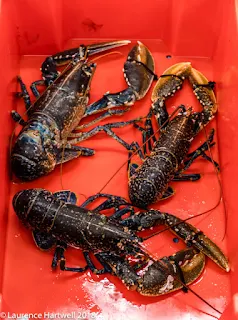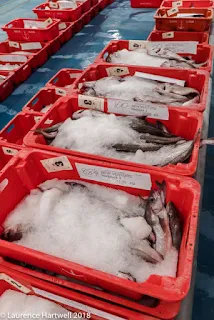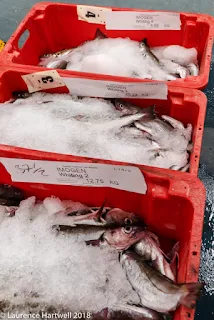Revised rules relating to fishing for sea bass apply from midnight 31 January 2019.
Fishing nets
Following the publication of the 2019 Total Allowable Catch Regulation in the official journal of the European Union, the revised rules relating to fishing for sea bass now apply.
Commercial fishing for seabass
Commercial fishing vessels are prohibited from fishing for seabass in ICES divisions 4b and 4c, and in ICES subarea 7 during 01 February to 31 March 2019. Commercial fishing from the shore, within these areas, is prohibited for the entirety of 2019.
Those commercial fishing vessels with authorisation to do so from the MMO may catch and retain bass during 1 April to 31 December 2019. The MMO will be writing to all fishing vessel owners who have a current authorisation to catch and retain bass and providing further guidance on our website soon.
Recreational fishing for seabass
Recreational fisheries, including from shore, in ICES divisions 4b, 4c, 6a, 7a to 7k are limited to catch-and-release only during 01 February to 31 March and 1 November to 31 December 2019. From 1 April to 31 October 2019, not more than one seabass may be retained per fisherman per day.
In recreational fisheries in ICES divisions 8a and 8b, a maximum of three seabass may be retained per fisherman per day.
Published 31 January 2019
From: Marine Management Organisation
-----------------------------------------------Merry Xmas and all the best for 2025!----------------------------------------
Showing posts with label bass. Show all posts
Showing posts with label bass. Show all posts
Friday, 1 February 2019
Update on fishing for sea bass in 2019
Thursday, 18 October 2018
Please take part in the 2018 Bass Survey for Sea Bass Fisheries Conservation UK (SBFC UK).
Please read the following information before starting the survey.
All fishers, both recreational and commercial across the UK (excluding Scotland) can take part in this survey. If you are not a fisher, please email us for further details on how you can contribute. SBFC UK is a project tasked with describing sea bass fisheries on a regional level to help improve future sea bass conservation and management. This survey allows us to complete that description by gathering information directly from you, we will collate this evidence to create an accurate picture of regional sea bass fisheries in the UK. We also want to underline where data gaps are to help prioritise our science to best suit the needs of fishers in each region. We hope to address these data gaps through fisher-led data collection and collaborations, email us for more details.
To take the survey please click here:
Once you've completed the survey, please feel free to share this survey using the link: https://tinyurl.com/SBFC-UK-Bass-Survey-2018
Important guidelines:
This is a confidential survey and will take approximately 10-15 minutes. Only one entry can be submitted per person, to enter for more than one individual, using one device, please contact us. You can go back and edit your responses until you exit the survey by selecting "Go Back". You cannot save your progress between sessions, so please complete the survey before exiting. You can keep an eye on your progress with the progress bar at the bottom of each page.
This survey closes on the 31st December 2018 at 23:59. Thank you for your participation!
If you experience any issues please email sbfc@cefas.co.uk.
Wednesday, 17 October 2018
Mid-week fish market in Newlyn.
The morning auction huddle begins around...
box stacks six high of line caught mackerel...
a few bass...
and a handful of squid...
also stacked are the boxes of hake from the only netter to land this morning, the Joy of Ladram...
other fish ready for this morning's auction include a few sardines...
red mullet...
ray...
and John Dory...
while this single cuttlefish from the Danmark just about sums up the seemingly non-existent cuttlefish season to date...
outnumbered by trawl caught lobster!..
and bream...
this conger would make a whole lot of fish cakes - for which it does an excellent job, add plenty of butter and fresh parsley to the mix for a real treat...
despite the early hour and going against the natural body clocks, much of the sale is carried out in good humour...
especially with stunning fish like these line caught bass...
and a big shot of ray from the Imogen III...
now and then the odd tuna gets caught on the lines...
inshore trawl fish, predominately flats like Dover, megrim and lemon sole...
along with the inevitable haddock catch...
although young Roger on the Imogen III...
just can't help mixing it with those John Dory whenever he gets the chance...
these days the boats seldom land good shots of whiting which, as a species, seem to have been usurped by the now very plentiful but sadly almost quota-less haddock - the fish that in ICES Area VII will undoubtedly be the fish that causes the biggest headache as the (seemingly unworkable) LO (Landing Obligation) kicks in next year...
as Brexit talks come to a head, spot the interlopers from across the channel...
through the square doorway this morning...
name this fish...
with its vicious looking dorsal spines...
though bass are not without spiky bits - the gill plates on these gorgeous fish are blessed with a single sharp point that has caught many an angler out when handling a wriggling bass for the first time...
taking a berth at the ice works, the Amanda of Ladram...
the sale is almost over.
Labels:
bass,
fish auction,
Newlyn,
stone bass,
tuna
Friday, 12 January 2018
Fishing for a Future? Challenges and Opportunities Facing UK Fishing Communities Revealed at ‘UK Fishing Forum’
On 9 January 70 representatives from the fishing industry including fishermen, fish producers, policy makers and funders, attended an event at Fishmongers’ Hall organised by Seafarers UK and hosted by The Fishmongers’ Company. They were there to discuss the interim findings from a major new piece of research compiled by Cornwall Rural Community Charity and Rose Regeneration.
The ‘Fishing for a Future’ research is based on an analysis of 41 fishing ports around the UK. It involved an extensive survey of fishermen’s own views on the key issues impacting their lives as well as a survey of 70 health service providers in fishing communities. Many areas of need were identified, including: a lack of funding for simple port infrastructure and equipment; low workforce recruitment and retention; poor health amongst fishermen, with most suffering from a disability or long-term health problem; many fishing families facing financial difficulties, and the knock-on effects of a limited access to quota for the stability of fishermen’s personal circumstances.
 |
| 1800 kg of bass accidentally caught by an inshore trawler on the day of the conference - value approx £21,000 - about to be thrown back overboard! |
The ‘UK Fishing Forum 2018’ invited guests to quiz the report’s authors and other experts (see list below). Dave Cuthbert of the New Under 10m Fishermen’s Association, a panellist, said: ‘It isn’t fun to throw fish overboard and watch them drift away when you have a mortgage to pay. It exemplifies a broken system and highlights that small scale fishermen are hemmed in by regulation’. Griffin Carpenter, Senior Researcher at the New Economics Foundation felt that: ‘Fishing has been left out of the political system. Fishermen need coherent structures to give them a voice.’
The report also highlighted those areas of potential opportunity for pro-active work in tackling the need and challenges identified in the research, these being: the use of credit unions, money advice and pensions; training in numeracy, literacy and core skills; greater analysis and understanding of migrant workers; building upgrades and small harbour infrastructure; better health outreach; business development support; better workforce recruitment and retention, and the use of animateurs to help fishermen reach their full potential.
Barry Bryant, chair of the Forum and Director General of Seafarers UK, commented: ‘This work is timely in shining a light on a little understood community of resilient and resourceful fishermen who have often missed out on “one size fits all” social and economic interventions. The aim is that this research will provide an agenda for future action, and we hope that by fishermen, charities, support bodies and Government working together, we can make a significant and sustainable impact at this time of change for the UK fishing community that is such an important and financially viable part of our Island Nation.’
UK fishing sector facts highlighted in the report:
- Fishing and fish processing employ 22,000 people within the UK total of 28.5 million jobs
- The overall impact of the UK fishing sector is worth £1.14 billion
- In 2015 around 12,000 people were directly employed in fishing (in 1987 the figure was approaching 25,000)
- Over 20% of all those working directly as fishermen are non-EU workers
- 12,000 fishing jobs support at least a further 4,000 jobs in the wider economy, as well as their own extended families
- £552 million value of landings contributes that amount again in wider added value; making the overall impact of the UK fishing sector worth £1.14 billion.
- Speakers and panellists at ‘Fishing Forum 2018’:
- Ivan Annibal, Managing Director, Rose Regeneration
- Griffin Carpenter, Senior Researcher, New Economics Foundation
- Hazel Curtis, Chief Economist, Seafish
- Dave Cuthbert, Co-Chairman, NUTFA (New Under 10m Fishermen’s Association)
- David Dickins, Chief Executive, Fishermen’s Mission
- Robert Greenwood, Safety Officer, National Federation of Fishermen’s Organisations
- Andrew Pascoe, Fisherman (over 10 metres)
- Jerry Percy, Executive Director, LIFE (Low Impact Fishers of Europe) and Chairman, Coastal Producer Organisation
- Rob Poole, Rural Economist, Cornwall Rural Community Charity
- Simon Potten, Head of Safety, Training & Services, Seafish
- Chris Ranford, Fisheries Communities Animateur, Cornwall Rural Community Charity
- Dr Rachel Turner, Lecturer in Environmental Social Science, Exeter University
- Lysanne Wilson, Health Development Officer, Seafarers Hospital Society.
The interim ‘Fishing for a Future’ report is available to download at: http://bit.ly/2DbfdYj. The final report, due to be published in late Spring, will be informed by both the Forum’s discussions and any additional feedback on the interim findings from the full spectrum of the fishing community.
Feedback and input on the interim research is invited, by email to fishingforum@seafarers.uk, phone 020 7932 5965, or write to Fishing Forum, Seafarers UK, 8 Hatherley Street, London, SW1P 2QT.
Labels:
bass,
CFPO,
Fishing for a future,
inshore fishing,
Under 10m
Friday, 17 November 2017
The mighty gurnard
Twenty years ago 99% of the gurnards caught by trawlers in Newlyn were sold as 'stocky' to the local crab boats to use as bait. Only the biggest 'tub' gurnards were put on the market for auction - and they made only a few pence per kilo. Enter the era of the environmental activists riding on the back of high-profile media campaigns citing over-fishing and a CFP that sought to address too many boats chasing too few fish. Then, the resultant drive to replace shrinking quotas for common species like haddock, cod and whiting with alternative species and suddenly the spikey, tough-skinned gurnard began to grace the dinner plates of more and more dishes in restaurants and homes here in the UK - largely championed by a new generation of post-Floyd TV chefs keen to be seen to offer sustainably and responsibly caught fish on their menus.
Gurnards come in three main guises - top to bottom - the larger and more meaty tub gurnard, the much smaller and sweeter red gurnard and its near cousin the grey gurnard...
colour variations between the species can be confusing though some red gurnards are bright red and some grey the dullest of greys but only the tub gurnard sports such iridescent pectoral fins...
Ask your local fishmonger to sell you some!
Friday, 10 November 2017
#FishyFriday in Newlyn.
Fish are stacked right up to the fridge door on a busy #FishyFriday auction...
which saw the top two bass men in the port go head-to-head with that man Cod aboard the Butts just landing a few kilos more than the Cynthia...
sample scallop from the Filly...
just arrived, fish from the bass boat Boy James gets weighed and graded for the auction...
Tom picked up a few Dovers from the inshore grounds...
while the Filadelfia picked away a good few tubs of cuttles for his landing...
Tom really hit the haddock again...
and even managed to tempt...
a few decent bass to cross the threshold of his trawl...
while Don landed a cracking shot of mixed ray...
the buyers quickly worked their way through the first landing of hake for the week from...
the Karen of Ladram...
looking superb they were too...
weighed and graded the tallies about to go on...
just before the buyers stepped in to buy the big bass shot - all of these fish were caught using pole and line...
though a quick look at the forecast for the coming days would indicate that there won't be many line caught bass anytime soon after tomorrow!..
buyers huddled around the Filadelfia's fish...
like these quality John Dory...
plaice, monk and megrim...
Newlyn under a very heavy sky this morning.
Labels:
bass,
cod,
line caught
Subscribe to:
Posts (Atom)























































